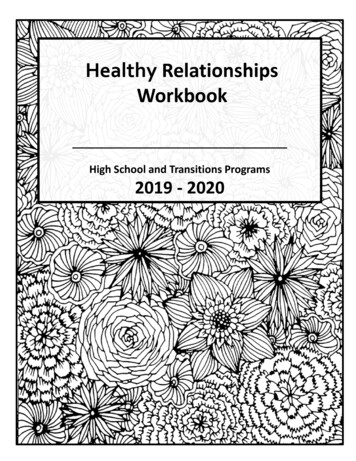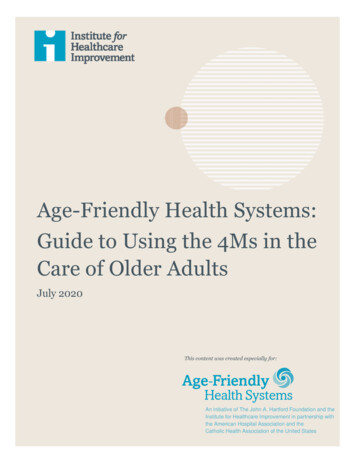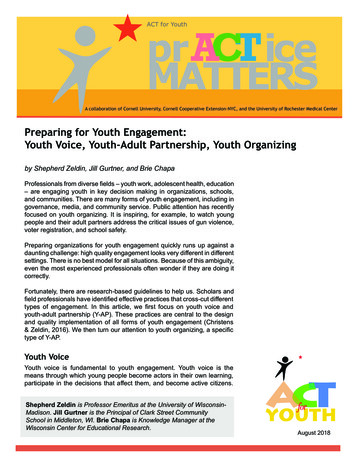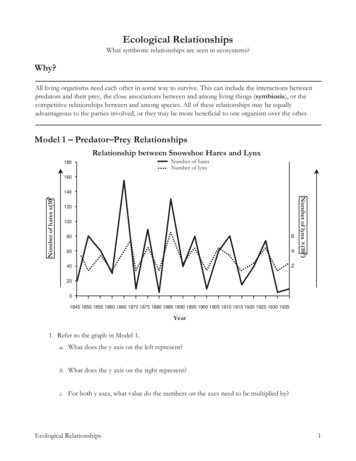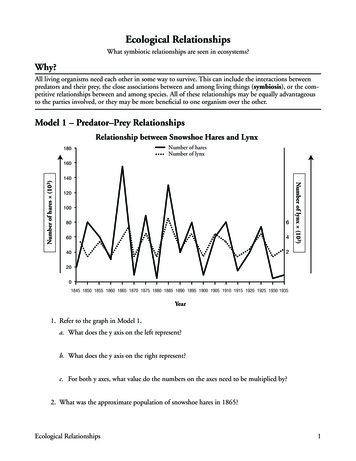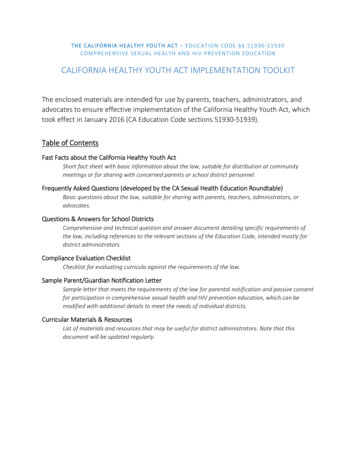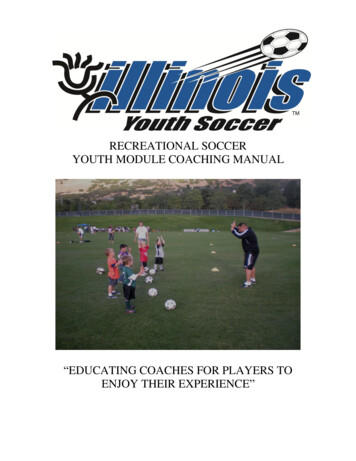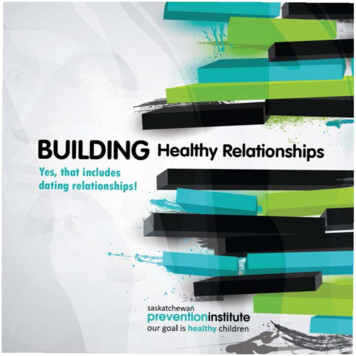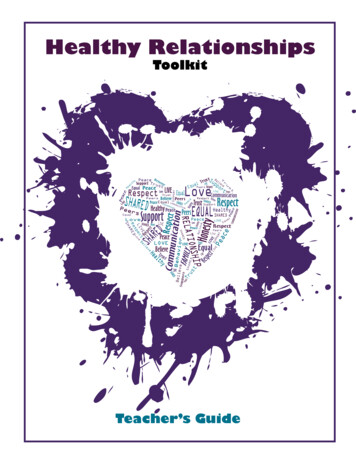
Transcription
Healthy RelationshipsToolkitTceORPPSUpecTrSupportPeaceSus LOVTrustuaELOVEEqRespectPeaceLOVEHe Believeal TrustthyLIVELovet HBeli ealthyeveD PeersspeAlVE t BeLI pec oves LRe COMPeace EqualFRIMUN AREDEPeacetCommunicationRespect BelieveSHAREDSupporteHea acelthyrEqual ePeerstLIVERespect BelievesEqual Peacestt Brus S ell T LIVE up ievEquaPeers Respect porelPComm eaceunicationBeuePeaceSupport Tru ieverhySHARED HealthyVELIltTaHeTeacher’s Guide
AcknowledgmentsThis report was made possible by the following individuals and agencies:Nicole AndersonSara AndersonMonica BaileyLisa BallandShauna BarfussPriscilla CabralPatsy ChandlerTrevor CrumpCarrie JensenBrandi LeCainRosa MartinezKatie McMinnKimberlee MontoyaCeCie ScharmanAshley SokiaJulie StephensonCindy TaylorMina UscharawadiMegan WatersJulie WernerWestminster CollegeCAPSAUtah State UniversityPlanned ParenthoodNew HopeCentro de la FamiliaUtah State PTAWestminster CollegePrevent Child Abuse UtahYour Community ConnectionCentro de la FamiliaUtah Department of HealthUtah Domestic Violence CouncilSalt Lake School DistrictWestminster CollegeSafe HarborRape Recovery CenterCenter for Women and Children in CrisisCenters for Disease Control and PreventionRape Recovery CenterFor more information contact:Mailing Address:Utah Department of HealthTelephone:801-538-6864Violence and Injury Prevention ProgramPO Box 142106Salt Lake City, UT 84114-2106Fax: 801-538-9134Email: vipp@utah.govWebsite: www.health.utah.gov/vippThis Toolkit was adapted for Utah classrooms from the evidence-based curriculum ‘Safe Dates’, whichhas been shown to significantly reduce psychological, sexual, and physical abuse and perpetrationin national studies.
Letter to the EducatorWelcome to the Healthy Relationships Curriculum! This curriculum was designed through cross-agencycollaboration for the purpose of teaching high school students about healthy relationships, choices, andcommunication. The curriculum addresses attitudes, opinions, and behaviors related to dating abuseand healthy relationships.This curriculum has been developed to fulfill a need identified by community educators and agencies,for a more current and relevant program that speaks frankly about relationships to a growing generation.This curriculum offers a holistic approach to teaching teens how to identify abusive dating behaviors andbuild healthy relationships. Topics such as values, equality, power, control, communication, and emotionalexpression are all covered. The toolkit allows any educator—from those with a limited background inteaching healthy relationships to those with extensive knowledge on the topic—to teach the lessons as awhole program, or to pick and choose which lessons best fit the students’ needs and classroom instruction.This curriculum was created with the Utah teen in mind, including a “Who Can Help?” section as a significantfeature located near the end of the manual. Resources from around the state have been thoroughlyresearched and listed on one convenient page to help provide teens with the support they need outsideof the classroom. National and local websites are also included in an effort to encourage teens to researchmore about the topics presented and to connect them to accurate and safe information on the Internet.We hope this toolkit can provide safe and engaging classroom time for both students and educators. Wealso hope it sheds light on an important part of adolescence that needs guidance and support. We areconfident the skills developed through the use of this curriculum will last a lifetime and enable peopleto make healthy choices in all of their relationships.
Section 1: Defining Healthy RelationshipsSection DescriptionThrough fun activities (such as the Relationship Circle and Relationship Bingo) and class discussion, students beginto identify what creates a healthy, respectful relationship and consider how they want to be treated in the contextof a relationship.Preparation Copies of pages 1–5 of the student packet for each student. Optional: Prize for the winner of Relationship Bingo.Explain to your students: We’re here today to talk about relationships. The activities in your packetand the topics we will be covering will help you in all the relationships in your life. This packet will help youstrengthen the relationship you have with your parents, friends, peers, and people you date.We will be talking about:What a healthy and unhealthy relationship looks like.How people in our lives make us feel and how we deal with it.How we communicate with people we love.PART 1: RELATIONSHIP CIRCLEPurpose: To help students identify the relationships they have with different people, how those relationships are different, and what those relationships mean tothem.Love RESPECT Shared Peers Love Believe Peace Equal Communication HealthySupport Live Peace EQUAL LIVE RESPECT Shared Peers Love Believe Trust Peace EQUALPeaceEQUAL LoveRESPECT Shared Peers Love1. Have your students begin filling out the relationship circle on Communication HEALTHYRelationshipSupport LiveCircleBelieve Peace Equal Communication Healthy Support Live Peace EQUAL LIVEpage 1 of their student packet by writing their name in the RESPECT Shared Peers Love Believe Trust Peace EQUAL Communication HEALTHY SupportLive Peace EQUAL Love RESPECT Shared Peers Love Believe Peace Equalmiddle circle.Communication Healthy Support Live Peace EQUAL LIVE RESPECT Shared Peers Love BelieveTrust Peace EQUAL Communication HEALTHY Support Live Peace EQUAL Love RESPECT SharedPeers Love Believe Peace Equal Communication Healthy Support Live PeaceEQUAL LIVE RESPECT Shared Peers Love Believe Trust Peace EQUAL Communication HEALTHY2. Have your students write the names of the people they have closeSupport Live Peace EQUAL Love RESPECT Shared Peers Love Believe PeaceCommunication Healthy Support Live Peace EQUAL LIVE RESPECT Shared Peers Loverelationships with in the next circle. These people can be a family EqualBelieve Trust Peace EQUAL Communication HEALTHY Support Live Peace EQUAL LoveRESPECTmember, friend, etc.Shared Peers Love Believe Peace Equal Communication Healthy SupportLive Peace EQUAL LIVE RESPECT Shared Peers Love Believe Trust Peace EQUAL CommunicationHEALTHY Support Live Peace EQUAL Love RESPECT Shared Peers Love BelieveEqual Communication Healthy Support Live Peace EQUAL LIVE RESPECT SharedPeace3. Have your students write the names of people they know but PeersLove Believe Trust Peace EQUAL Communication HEALTHY Support Live Peace EQUALLOVE RESPECT Shared Peers Love Believe Peace Equal Communication Healthymay not have a close relationship with in the outermost circle, for SupportLive Peace EQUAL LIVE RESPECT Shared Peers Love Believe Trust Peace EQUALCommunication HEALTHY Support Live Peace EQUAL Love RESPECT Shared Peers Loveexample, a coach, a teacher, a boss, or a neighbor.Believe Peace Equal Communication Healthy Support Live Peace EQUAL LIVERESPECT Shared Peers Love Believe Trust Peace EQUAL Communication HEALTHY SupportLive Peace EQUAL Love RESPECT Shared Peers Love Believe Peace Equal4. Ask your students, “If you were dating someone, what circle Communication Healthy Support Live PeaceEQUAL LIVE RESPECT Shared Peers Love BelieveTrust Peace EQUAL Communication HEALTHY Support Live Peace EQUAL Love RESPECT Sharedwould that person be in?” Explain to students that for the next Peers Love Believe Peace Equal Communication Healthy Support Live PeaceShared Peers Love Believe Trust Peace EQUAL Communication HEALTHYfew minutes they will be talking about the relationship they have EQUAL LIVELiveRESPECTPeace EQUAL Love RESPECT Shared Peers Love Believe PEACESupportEqual1 Communication Healthy Support Live Peace EQUAL LIVE RESPECT Shared Peers Lovewith the person they are dating.Believe Trust Peace EQUAL Communication HEALTHY Support Live Peace EQUAL LoveBelieveRESPECTShared Peers LovePeace Equal Communication Healthy SupportLive Peace EQUAL LIVERESPECT Shared Peers Love Believe Trust Peace EQUAL CommunicationI have a relationshipbut am not close with.My closest relationshipsare with.My Name is.Section 1: Defining Healthy Relationships5. Begin by asking your students the following questions:What do you think of when you think of dating?What are some activities you do when you are dating?6. Have one of the students write the responses on the board.This list of responses serves as a collective definition of what dating is to thisparticular group and can be referred to throughout the remainder of thelesson.1
Section 1: Defining Healthy RelationshipsPART2: DATING BINGOPurpose: To help students think about dating and making choices about dating.1. Have students go to page 2 of their packets.2. Review the directions listed on the Dating Bingo page.3. Give students one minute to circle boxes and about four minutes to walk around and collect signatures.4. After someone yells Bingo, check the card, and if possible, award the winner with a prize (candy, pencil,or extra credit, etc.).5. Discuss with your students what traits they chose and why. Then ask the students if they noticed someof the traits you would look for in a dating partner for a friend.LoveHealthyEQUAL BingoRESPECT Peers LoveSupportRelationshipBelieve Peace Equal Communication Healthy Support Live Peace EQUAL LIVERESPECT Shared Peers Love Believe Trust Peace EQUAL Communication HEALTHY SupportLive Peace EQUAL Love RESPECT Shared Peers Love Believe Peace EqualCommunication Healthy Support Live Peace EQUAL LIVE RESPECT Shared Peers Love BelieveTrust Peace EQUAL Communication HEALTHY Support Live Peace EQUAL Love RESPECT SharedPeers Love Believe Peace Equal Communication Healthy Support Live PeaceEQUAL LIVE RESPECT Shared Peers Love Believe Trust Peace EQUAL Communication HEALTHYSupport Live Peace EQUAL Love RESPECT Shared Peers Love Believe PeaceEqual Communication Healthy Support Live Peace EQUAL LIVE RESPECT Shared Peers LoveBelieve Trust Peace EQUAL Communication HEALTHY Support Live Peace EQUAL LoveRESPECT Shared Peers Love Believe Peace Equal Communication Healthy SupportLive Peace EQUAL LIVE RESPECT Shared Peers Love Believe Trust Peace EQUAL CommunicationHEALTHY Support Live Peace EQUAL Love RESPECT Shared Peers Love BelieveEqual Communication Healthy Support Live Peace EQUAL LIVE RESPECT SharedPeacePeers Love Believe Trust Peace EQUAL Communication HEALTHY Support Live Peace EQUALLOVE RESPECT Shared Peers Love Believe Peace Equal Communication HealthySupport Live Peace EQUAL LIVE RESPECT Shared Peers Love Believe Trust Peace EQUALCommunication HEALTHY Support Live Peace EQUAL Love RESPECT Shared Peers LoveBelieve Peace Equal Communication Healthy Support Live Peace EQUAL LIVERESPECT Shared Peers Love Believe Trust Peace EQUAL Communication HEALTHY SupportLive Peace EQUAL Love RESPECT Shared Peers Love Believe Peace EqualCommunication Healthy Support Live Peace EQUAL LIVE RESPECT Shared Peers Love BelieveTrust Peace EQUAL Communication HEALTHY Support Live Peace EQUAL Love RESPECT SharedPeers Love Believe Peace Equal Communication Healthy Support Live PeaceLove RESPECT Shared PeersBelieve Peace Equal CommunicationSupportPeace EQUAL LIVE RESPECT Shared Peers Love Believe Trust Peace RECTIONS1. Think of someone you have a relationship with as you read each box below.2. Circle the five traits you think are important for that person to have.3. Find five different people in the room who have circled one of the same traits.4. Have them sign in that box.5. The first person to get all five boxes signed by a different person shouts “Bingo.”funnyuniqueolder thanmehonestconfidentromanticsmartrichathletica goodlistenerindependentEQUAL LIVE RESPECT Shared PeersSupportsupportivepopularnice tootherpeoplea moviefanaticartsyweird andwackyadventurousoutgoingpassionateLove Believe Trust Peace EQUAL Communication HEALTHYLoveSupportPEACE2Live Peace EQUALLove RESPECT SharedRelationshipsPeersBelieveSection 1: Defining HealthySupportPeace EQUAL LIVE RESPECT Shared Peers LoveEqual CommunicationLive Peace EQUAL LoveBelieve Trust Peace EQUAL Communication edPeace EQUAL LIVE RESPECT Shared Peers Love Believe Trust Peace EQUAL CommunicationLiveHealthyPeers LoveLivePeaceHealthy2
Section 1: Defining Healthy RelationshipsPART 3: CARING PEOPLE AND CARING RELATIONSHIPSPurpose: To have students explore relationships that make them feel good aboutthemselves.1. Explain to your students: Dating Bingo was supposed to help them identify qualities andcharacteristics they want in someone they are dating.2. Have students go to page 3 of their packets and read the instructions under entry 1. Give studentsa minute to write their list.3. Read the instructions under entry 2. Give students about five minutes to do this.4. Ask the following question when students are finished, and have a student write their responses on theboard:What are some ways people have treated you that have helped you feelgood about yourself?5. Draw out or highlight some of the students’ top answers. The list may look something like this: They respected me. They trusted me.Love RESPECT Shared Peers Love Believe Peace Equal Communication HealthySupport Live Peace EQUAL LIVE RESPECT Shared Peers Love Believe Trust Peace EQUAL They listened to me.PeaceHEALTHYEQUAL LoveandRESPECT Shared Peers LoveCommunicationSupport Live PeopleCaring They believed in me.Support Live Peace EQUAL LIVEBelieve PeaceEqual CommunicationHealthyCaringRelationships They encouraged me.RESPECT Shared Peers Love Believe Trust Peace EQUAL Communication HEALTHY Support They cared about me.Live Peace EQUAL Love RESPECT Shared Peers Love Believe Peace EqualHealthyExplain to your students: You should take thestudents’ responses and relate them to one of the itemsbulleted. For example:LivePeace EQUAL LIVE RESPECT Shared Peers Love BelieveList people in your life who have helped you feel good about yourself. These people mayfamily membersor friends. They may have beenLivein yourlife for aEQUALshort timeLoveor for a RESPECTTrust Peace EQUALbeCommunicationHEALTHYPeaceSharedlong time. They may not be part of your life anymore. You can list names or the person’sCommunicationEntry 1SupportSupportPeers Love Believe Peace Equal Communication Healthy Support Live Peacerelationship to you (such as father, mother, or history teacher).EQUAL LIVE RESPECTShared Peers Love Believe Trust Peace EQUAL Communication HEALTHYSupport Live Peace EQUAL Love RESPECT Shared Peers Love Believe PeaceLiveHealthySupportStudent’s response:RESPECT Shared Peers Love Believe Peace Equal Communication Healthy Support“My mom told me I was really good at soccer and I should Live Peace EQUAL LIVE RESPECT Shared Peers Love Believe Trust Peace EQUAL CommunicationHEALTHY Support Live Peace EQUAL Love RESPECT Shared Peers Love Believetry out for a school team.”Equal Communication Healthy Support Live Peace EQUAL LIVE RESPECT SharedPeacePeers Love Believe Trust Peace EQUAL Communication HEALTHY Support Live Peace EQUALLOVE RESPECT Shared Peers Love Believe Peace Equal Communication HealthyTeacher’s response:Support Live Peace EQUAL LIVE RESPECT Shared Peers Love Believe Trust Peace EQUAL“So, your mom was encouraging you and believed in Communication HEALTHY Support Live Peace EQUAL Love RESPECT Shared Peers Loveyour ability as a soccer player.”Believe Peace Equal Communication Healthy Support Live Peace EQUAL LIVERESPECT Shared Peers Love Believe Trust Peace EQUAL Communication HEALTHY SupportLivePeace EQUAL Love RESPECT Shared Peers Love Believe Peace EqualPoint out that these things are important in anyCommunication Healthy Support Live Peace EQUAL LIVE RESPECT Shared Peers Love BelieveTrust Peace EQUAL Communication HEALTHY Support Live Peace EQUAL Love RESPECT Sharedrelationship, whether it is a dating relationship or thePeersLove Believe Peace Equal Communication Healthy Support Live Peacerelationship you have with a friend, sibling, or parent.EQUAL LIVE RESPECT Shared Peers Love Believe Trust Peace EQUAL Communication HEALTHYLive Peace EQUAL Love RESPECT Shared Peers Love Believe PEACESupportCommunication Healthy Support Live Peace EQUAL LIVE RESPECT Shared Peers LoveEqual3Believe Trust Peace EQUAL Communication HEALTHY Support Live Peace EQUAL LoveBelieveRESPECTSupportShared Peers LovePeace Equal Communication HealthyCommunicationLive Peace EQUAL LIVE RESPECT Shared Peers Love Believe Trust Peace EQUALSupportPeace EQUAL LIVE RESPECT Shared Peers LoveEqual CommunicationBelieve Trust Peace EQUAL Communication HEALTHYLive Peace EQUAL LoveEntry 2You have written down the names of some people who have helped you feel good aboutyourself. Now think about what these people did to help you feel this way. Describe someof the ways they treated you.Section 1: Defining Healthy Relationships3
Section 1: Defining Healthy RelationshipsPART 4: HOW I WANT TO BE TREATED BY PEOPLE I CARE ABOUTPurpose: To have students identify the ways they want to be treated.1. Explain to your students:a. We all have different types of relationships.b. We all want to have relationships with people who respect our opinions, encourage us, andsupport us during our hard times.c. It is important for us to have a clear idea of how we want to be treated by other people.2. Have students go to page 4 of their packets.3. Read the directions: “Below are a figure and a list of ways people may treat each other. The figure representsyou. On the two solid lines above the figure, write the two most important ways you want to be treatedby someone you care about. On the dotted lines surrounding the figure, list five additional actions thatare important to you. Feel free to write in ideas that aren’t on the list.”4. Have the students complete the activity.5. Have a discussion with your students about the items they selected.LoveHealthyEQUAL to RESPECTPeers LoveSupportHow I WantBeSupport Live Peace EQUAL LIVEBelieve PeaceEqual CommunicationHealthyTreatedbyPeopleRESPECT Shared Peers Love Believe Trust Peace EQUAL Communication HEALTHY SupportI CareAboutLive Peace EQUAL Love RESPECTShared Peers Love Believe Peace EqualCommunication Healthy Support Live Peace EQUAL LIVE RESPECT Shared Peers Love BelieveTrust Peace EQUAL Communication HEALTHY Support Live Peace EQUAL Love RESPECT SharedPeers Love Believe Peace Equal Communication Healthy Support Live PeaceEQUAL LIVE RESPECT Shared Peers Love Believe Trust Peace EQUAL Communication HEALTHYSupport Live Peace EQUAL Love RESPECT Shared Peers Love Believe PeaceEqual Communication Healthy Support Live Peace EQUAL LIVE RESPECT Shared Peers LoveBelieve Trust Peace EQUAL Communication HEALTHY Support Live Peace EQUAL LoveRESPECT Shared Peers Love Believe Peace Equal Communication Healthy SupportLive Peace EQUAL LIVE RESPECT Shared Peers Love Believe Trust Peace EQUAL CommunicationHEALTHY Support Live Peace EQUAL Love RESPECT Shared Peers Love BelievePeace Equal Communication Healthy Support Live Peace EQUAL LIVE RESPECT SharedPeers Love Believe Trust Peace EQUAL Communication HEALTHY Support Live Peace EQUALLOVE RESPECT Shared Peers Love Believe Peace Equal Communication HealthySupport Live Peace EQUAL LIVE RESPECT Shared Peers Love Believe Trust Peace EQUALCommunication HEALTHY Support Live Peace EQUAL Love RESPECT Shared Peers LoveBelieve Peace Equal Communication Healthy Support Live Peace EQUAL LIVERESPECT Shared Peers Love Believe Trust Peace EQUAL Communication HEALTHY SupportLive Peace EQUAL Love RESPECT Shared Peers Love Believe Peace EqualCommunication Healthy Support Live Peace EQUAL LIVE RESPECT Shared Peers Love BelieveTrust Peace EQUAL Communication HEALTHY Support Live Peace EQUAL Love RESPECT SharedPeers Love Believe Peace Equal Communication Healthy Support Live PeaceLove RESPECT Shared PeersBelieve Peace Equal CommunicationSupportPeace EQUAL LIVE RESPECT Shared Peers Love Believe Trust Peace RECTIONSBelow is a figure and a list of ways people may treat each other. The figure represents you.On the two solid lines above the figure, write the two most important ways you want to betreated by someone you care about. On the five dotted lines surrounding the figure, list fiveadditional actions that are important to you. Feel free to write in ideas that aren’t on the dedcared foramused ormade tolaughchallengedencouragedcheated onlistened totreatedtreated like aking or queenequallyEQUAL LIVE RESPECTShared Peerstreatedhonestly HEALTHYLove Believe Trust Peace EQUAL CommunicationLive Peace EQUAL Love RESPECT Shared Peers Love Believe PEACESupportEqual Communication Healthy Support Live Peace EQUAL LIVE RESPECT Shared Peers4LoveBelieve Trust Peace EQUAL Communication HEALTHY Support Live Peace EQUAL LoveBelieveRESPECTSupportShared Peers LovePeace Equal Communication HealthyCommunicationLive Peace EQUAL LIVE RESPECT Shared Peers Love Believe Trust Peace EQUALSection 1: Defining Healthy Relationships4
Section 1: Defining Healthy RelationshipsPART 5: EQUALITY WHEELPurpose: To have students review characteristics of a healthy relationship.1. Have students go to page 5 in their student packets.2. Explain to your students:a. This is the equality wheel.b. Equality is in the middle circle because we want to be equals in all of our relationships.3. Have one student read one of the sections of the equality wheel. Ask the other students to give examplesof an action that would demonstrate the concept that is addressed in that section.4. Continue steps 2 and 3 until all sections of the wheel are addressed.TEACHER’S GUIDEAsk your students the question, “How do we develop healthy relationships with people we love?”Refer to the “Equality Wheel.” This list will provide some strategies for recognizing respectful andsupportive relationships and avoiding negative ones that you can discuss with your students.For more information about building healthy relationships and preventing dating violence, visit www.health.utah.gov/LoveHealthyRESPECT Peers LoveSupportEqualityEQUALWheelBelieve Peace Equal Communication Healthy Support Live Peace EQUAL LIVERESPECT Shared Peers Love Believe Trust Peace EQUAL Communication HEALTHY SupportLive Peace EQUAL Love RESPECT Shared Peers Love Believe Peace EqualCommunication Healthy Support Live Peace EQUAL LIVE RESPECT Shared Peers Love BelieveTrust Peace EQUAL Communication HEALTHY Support Live Peace EQUAL Love RESPECT SharedPeers Love Believe Peace Equal Communication Healthy Support Live PeaceEQUAL LIVE RESPECT Shared Peers Love Believe Trust Peace EQUAL Communication HEALTHYSupport Live Peace EQUAL Love RESPECT Shared Peers Love Believe PeaceEqual Communication Healthy Support Live Peace EQUAL LIVE RESPECT Shared Peers LoveBelieve Trust Peace EQUAL Communication HEALTHY Support Live Peace EQUAL LoveRESPECT Shared Peers Love Believe Peace Equal Communication Healthy SupportPeers Love Believe Trust Peace EQUALLive Peace EQUAL LIVE RESPECT SharedEqualityCommunicationHEALTHY Support Live Peace EQUAL Love RESPECT Shared Peers Love BelieveWheelPeace Equal Communication Healthy Support Live Peace EQUAL LIVE RESPECT SharedPeers Love Believe Trust Peace EQUAL Communication HEALTHY Support Live Peace EQUALLOVE RESPECT Shared Peers Love Believe Peace Equal Communication HealthySupport Live Peace EQUAL LIVE RESPECT Shared Peers Love Believe Trust Peace EQUALCommunication HEALTHY Support Live Peace EQUAL Love RESPECT Shared Peers LoveBelieve Peace Equal Communication Healthy Support Live Peace EQUAL LIVERESPECT Shared Peers Love Believe Trust Peace EQUAL Communication HEALTHY SupportLive Peace EQUAL Love RESPECT Shared Peers Love Believe Peace EqualCommunication Healthy Support Live Peace EQUAL LIVE RESPECT Shared Peers Love BelieveTrust Peace EQUAL Communication HEALTHY Support Live Peace EQUAL Love RESPECT SharedPeers Love Believe Peace Equal Communication Healthy Support Live PeaceEQUAL LIVE RESPECT Shared Peers Love Believe Trust Peace EQUAL Communication HEALTHYLive Peace EQUAL Love RESPECT Shared Peers Love Believe PEACESupportCommunication Healthy Support Live Peace EQUAL LIVE RESPECT Shared Peers LoveEqual5Believe Trust Peace EQUAL Communication HEALTHY Support Live Peace EQUAL LoveBelieveRESPECTShared Peers LovePeace Equal Communication Healthy SupportLive Peace EQUAL LIVERESPECT Shared Peers Love Believe Trust Peace EQUAL CommunicationLove RESPECT Shared PeersBelieve Peace Equal CommunicationPeace EQUAL LIVE RESPECT Shared Peers Love Believe Trust Peace dLiveNEGOTIATIONAND FAIRNESS:Seeking mutuallysatisfying resolutionsto conflict. Acceptingchanges. Being willingto compromise.NON-THREATENINGBEHAVIOR:Talking and acting so thatexpressing feelings iscomfortable. Acting in a waythat creates a safe feelingand environment.RESPECT:COMMUNICATION:Willingness to have open andspontaneous dialogue. Problemsolving and compromising soeach person is happy with thedecision.Listen without expressingjudgment. Beingemotionally affirming andunderstanding. Value theopinions of others. Havinga balance of giving andreceiving.TRUST AND SUPPORT:SHARED POWER:Supporting each other’s goalsin life. Respecting each other’sright to their own feelings,friends, activities, and opinions.Taking mutualresponsibility andhaving equal influenceon the relationship.Making decisionstogether.SELF-CONFIDENCEAND PERSONALGROWTH:Respecting each other’spersonal identity andencouraging individualgrowth and freedom.Supporting each other’sself worth.HONESTY ANDACCOUNTABILITY:Accepting responsibilityfor self. Acknowledgingpast use of violence.Admitting being wrong.Communicating openlyand truthfully.Section 1: Defining Healthy Relationships5
Section 2: Defining Unhealthy RelationshipsSection DescriptionThrough fun activities (such as the Relationship Continuum and relationship scenarios) and class discussion, studentsbegin to identify what behaviors are defined as unhealthy or abusive.Preparation Copies of pages 6–10 of the student packet for each student. Dry erase board, markers, and dry eraser.PART 1: WHAT IS AN UNHEALTHY DATING RELATIONSHIP?Purpose: To have students begin to think about relationships that could be consideredunhealthy.1. Begin by asking your students the following questions:What comes to mind when you think of an abusive or unhealthy relationship?What are some things that happen in an abusive or unhealthy relationship?2. Have a student write the list on the board.3. Explain to your students: This list serves as a collective definition of what unhealthyrelationships are to this particular group. This list can be referred to throughout the remainder of the lesson.PART2: POWER AND CONTROL WHEELPurpose: To help students identify elements of an unhealthy relationship.1. Explain to your students: We’ve talked abouta caring relationship and how you want to be treated in arelationship. Now we will be discussing what an unhealthy orabusive relationship looks like.2. Have students go to page 6 in their student packets.3. Explain to your students:a. This is the power and control wheel.b. Power and control are in the middle circle because anabusive relationship occurs when one person in therelationship tries to have power and gain control overthe other Power & Control WheelBelieve Peace Equal Communication Healthy Support Live Peace EQUAL LIVERESPECT Shared Peers Love Believe Trust Peace EQUAL Communication HEALTHY SupportLive Peace EQUAL Love RESPECT Shared Peers Love Believe Peace EqualCommunication Healthy Support Live Peace EQUAL LIVE RESPECT Shared Peers Love BelieveTrust Peace EQUAL Communication HEALTHY Support Live Peace EQUAL Love RESPECT SharedPeers Love Believe Peace Equal Communication Healthy Support Live PeaceEQUAL LIVE RESPECT Shared Peers Love Believe Trust Peace EQUAL Communication HEALTHYSupport Live Peace EQUAL Love RESPECT Shared Peers Love Believe PeaceEqual Communication Healthy Support Live Peace EQUAL LIVE RESPECT Shared Peers LoveBelieve Trust Peace EQUAL Communication HEALTHY Support Live Peace EQUAL LoveRESPECT Shared Peers Love Believe Peace Equal Communication Healthy SupportPeers Love Believe Trust Peace EQUALLive Peace EQUAL LIVE RESPECT Shared PowerCommunication&HEALTHY Support Live Peace EQUAL Love RESPECTShared Peers Love BelieveControlSupport Live Peace EQUAL LIVE RESPECT SharedPeace Equal Communication Healthy WheelPeers Love Believe Trust Peace EQUAL Communication HEALTHY Support Live Peace EQUALLOVE RESPECT Shared Peers Love Believe Peace Equal Communication HealthySupport Live Peace EQUAL LIVE RESPECT Shared Peers Love Believe Trust Peace EQUALCommunication HEALTHY Support Live Peace EQUAL Love RESPECT Shared Peers LoveBelieve Peace Equal Communication Healthy Support Live Peace EQUAL LIVERESPECT Shared Peers Love Believe Trust Peace EQUAL Communication HEALTHY SupportLive Peace EQUAL Love RESPECT Shared Peers Love Believe Peace EqualCommunication Healthy Support Live Peace EQUAL LIVE RESPECT Shared Peers Love BelieveTrust Peace EQUAL Communication HEALTHY Support Live Peace EQUAL Love RESPECT SharedPeers Love Believe Peace Equal Communication Healthy Support Live PeaceEQUAL LIVE RESPECT Shared Peers Love Believe Trust Peace EQUAL Communication HEALTHYLive Peace EQUAL Love RESPECT Shared Peers Love Believe PEACESupportEqual Communication Healthy Support Live Peace EQUAL LIVE RESPECT Shared Peers6LoveBelieve Trust Peace EQUAL Communication HEALTHY Support Live Peace EQUAL LoveBelieveCommunicationRESPECTShared Peers LovePeace EqualHealthy SupportLive Peace EQUAL LIVERESPECT Shared Pe
strengthen the relationship you have with your parents, friends, peers, and people you date. We will be talking about: hat a healthy and unhealthy relationship looks like.W How people in our lives make us feel and how we deal with it. How we communicate with people we love. PART 1: RELATIONSHIP CIRCLE

